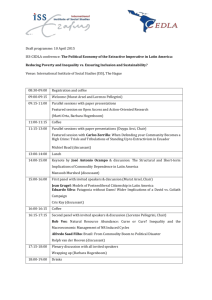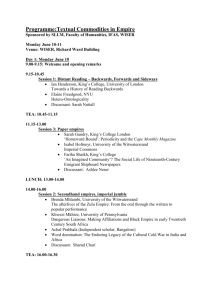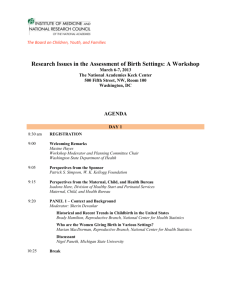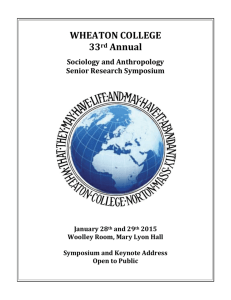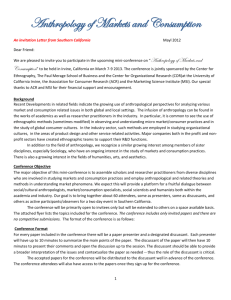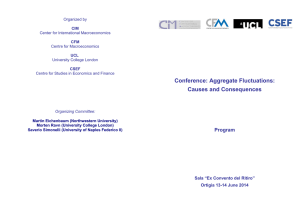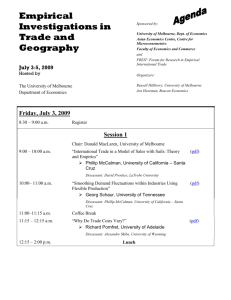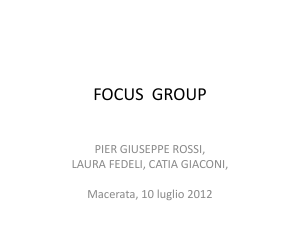Advocacy through Education: Course Development Proposal
advertisement
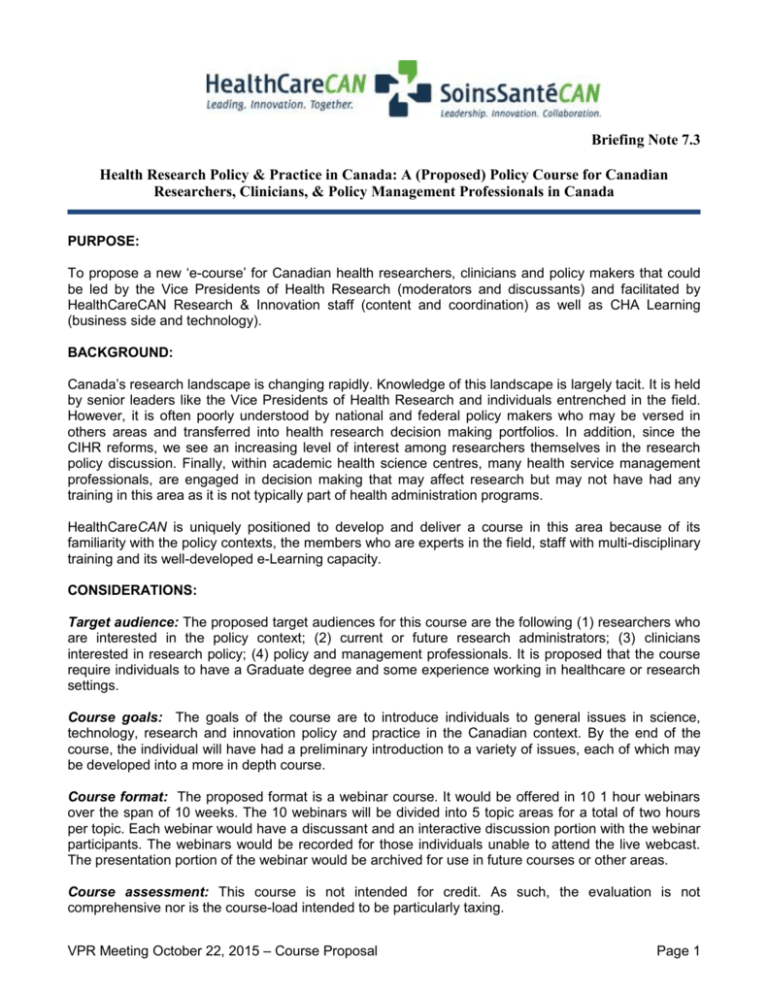
Briefing Note 7.3 Health Research Policy & Practice in Canada: A (Proposed) Policy Course for Canadian Researchers, Clinicians, & Policy Management Professionals in Canada PURPOSE: To propose a new ‘e-course’ for Canadian health researchers, clinicians and policy makers that could be led by the Vice Presidents of Health Research (moderators and discussants) and facilitated by HealthCareCAN Research & Innovation staff (content and coordination) as well as CHA Learning (business side and technology). BACKGROUND: Canada’s research landscape is changing rapidly. Knowledge of this landscape is largely tacit. It is held by senior leaders like the Vice Presidents of Health Research and individuals entrenched in the field. However, it is often poorly understood by national and federal policy makers who may be versed in others areas and transferred into health research decision making portfolios. In addition, since the CIHR reforms, we see an increasing level of interest among researchers themselves in the research policy discussion. Finally, within academic health science centres, many health service management professionals, are engaged in decision making that may affect research but may not have had any training in this area as it is not typically part of health administration programs. HealthCareCAN is uniquely positioned to develop and deliver a course in this area because of its familiarity with the policy contexts, the members who are experts in the field, staff with multi-disciplinary training and its well-developed e-Learning capacity. CONSIDERATIONS: Target audience: The proposed target audiences for this course are the following (1) researchers who are interested in the policy context; (2) current or future research administrators; (3) clinicians interested in research policy; (4) policy and management professionals. It is proposed that the course require individuals to have a Graduate degree and some experience working in healthcare or research settings. Course goals: The goals of the course are to introduce individuals to general issues in science, technology, research and innovation policy and practice in the Canadian context. By the end of the course, the individual will have had a preliminary introduction to a variety of issues, each of which may be developed into a more in depth course. Course format: The proposed format is a webinar course. It would be offered in 10 1 hour webinars over the span of 10 weeks. The 10 webinars will be divided into 5 topic areas for a total of two hours per topic. Each webinar would have a discussant and an interactive discussion portion with the webinar participants. The webinars would be recorded for those individuals unable to attend the live webcast. The presentation portion of the webinar would be archived for use in future courses or other areas. Course assessment: This course is not intended for credit. As such, the evaluation is not comprehensive nor is the course-load intended to be particularly taxing. VPR Meeting October 22, 2015 – Course Proposal Page 1 Course Content: The proposed Preliminary DRAFT Syllabus may be as follows: Topic 1. An introduction to ST&I landscape in Canada 2. An introduction to research funders 3. An introduction to health research and the media 4. An introduction to research impact 5. An introduction to academic health sciences centres 6. An introduction to the business machine behind health research 7. An introduction to partnership with the private sector. 8. An introduction to patient participation, public support 9. Playing in the Research and Research Policy Space 10. LEADS for health researchers and research policy makers. Learning Goal What are the seminal documents that policy makers follow to understand the research policy landscape and what is the policy making process influencing R& D? Who are the major federal granting councils in Canada, sources of funding, and their own policy challenges; How does the media discuss health research and researchers interactions with the media Why is it important to talk about research impact, what is the CAHS framework and its possible implications for practice What is the structure function and role of academic health science centres in Canada To understand the role of research coordinators, managers, REBs, GCPs, SOPs etc. To understand how health researchers in university and healthcare settings interact with the private sector To understand how communicating with patients and the public is important to the research endeavour What are the cultural differences between healthcare, research, and policy management settings that may affect how you communicate and speak across these areas? What is the LEADs Framework and how it might be used by those working in this area? Resources Discussant Use S&T Library Discussant: documents & others Moderator: Seminal Discussant: documents from granting councils Moderator: Innovation Sensation database Discussant: CAHS Framework Discussant: Moderator: Moderator: AHSN website Discussant: TBC Moderator: Discussant: Moderator: TBC Discussant: Moderator: TBC Discussant: Moderator: Lavis, Lomas Discussant: Articles re two communities etc. Moderator: LEADS brochure Discussant: and book. Moderator: Fee structure: The course is available in different fee schedules (i.e. full course vs. individual webinars or HealthCareCAN members vs. non-HealthCareCAN members vs. private or government sector vs. students/private individuals). TBD. VPR Meeting October 22, 2015 – Course Proposal Page 2 Next steps: (1) discuss internally (2) discuss with Vice Presidents of Health Research and modify the course proposal based on need and feedback (3) discuss with CHA learning for feasibility and then business modelling (4) confirm discussants and moderators and course materials (5) board approval and launch. DISCUSSION 1. 2. 3. 4. Is the idea in general worth pursuing? Are the topics and detailing correct? Would the VPRs be willing to get involved? If the course were handled by R&I staff, could CHA Learning handle business side? RECOMMENDATION No recommendations are forthcoming at this time. For information only. Prepared by: Tina Saryeddine Date: August 11, 2015 VPR Meeting October 22, 2015 – Course Proposal Page 3
